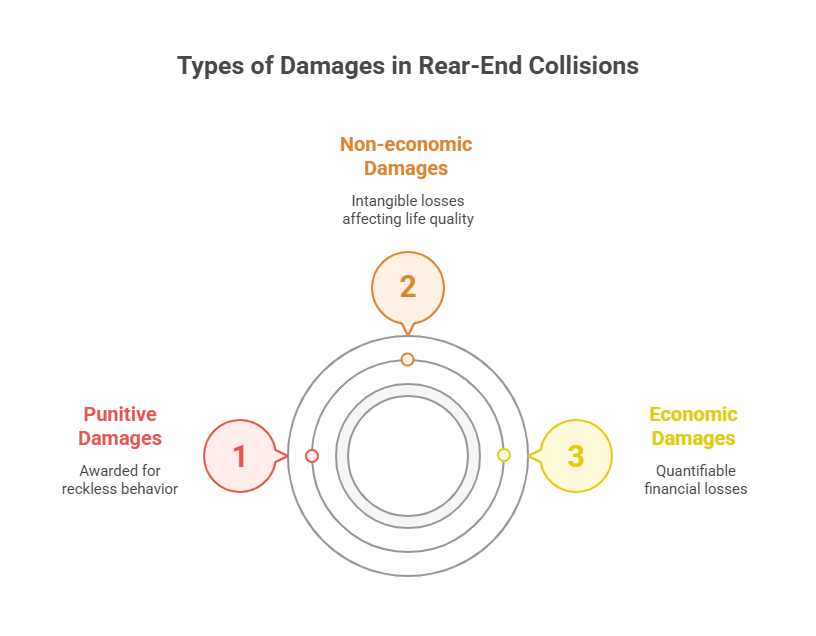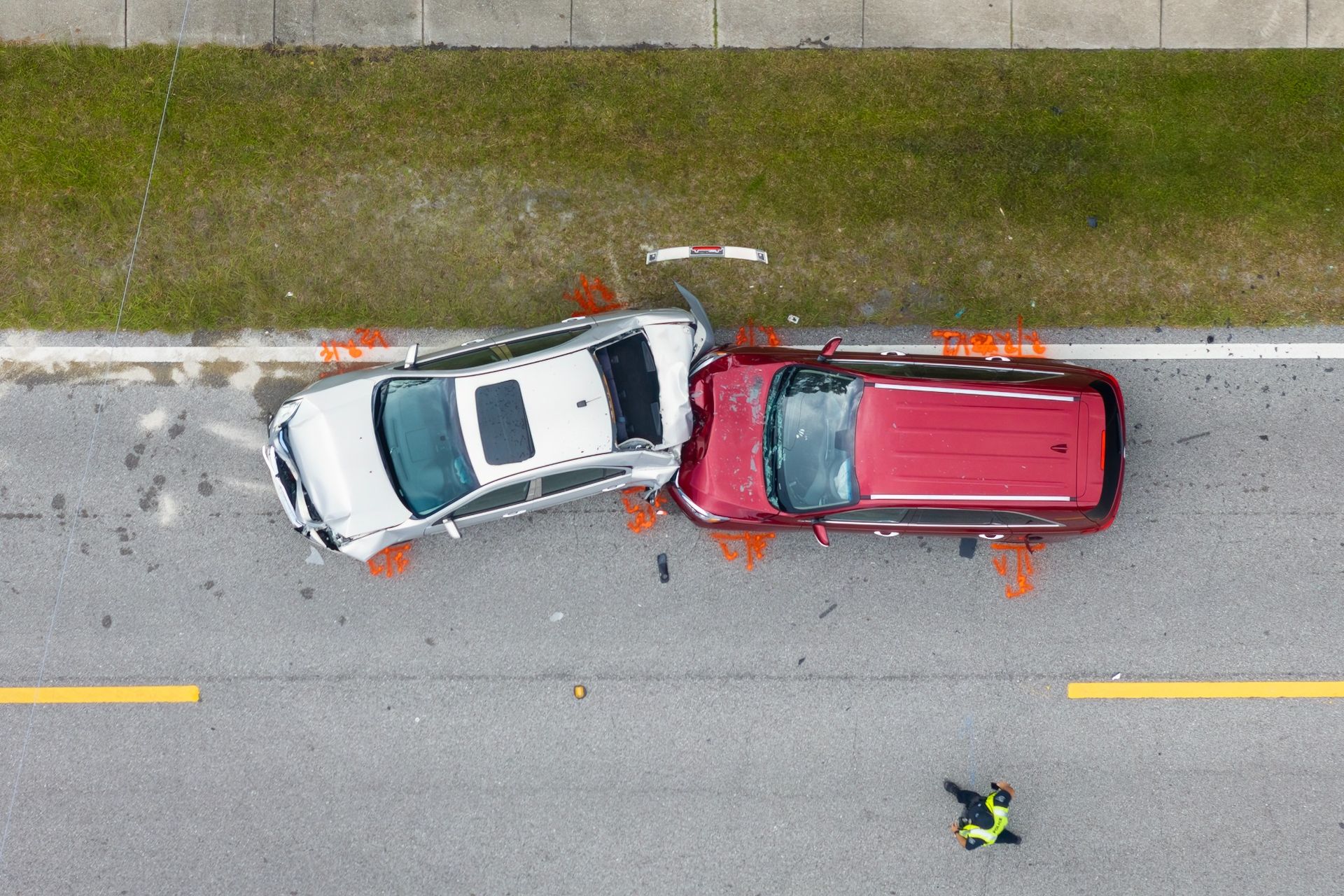The average payout for a rear-end collision in Connecticut ranges from $2,000 to $200,000. The settlement amount depends on several factors that can significantly impact your compensation:
- Severity of injuries
- Medical expenses
- Lost wages
- Pain and suffering
- Property damage
- Fault and liability
- Insurance policy limits
- Comparative negligence
- Legal representation
At Ganim Legal, P.C., we have secured substantial settlements for rear-end collision victims. Our case results include a $283,544 settlement for Sergio Proscino, who suffered serious neck and back injuries after being rear-ended while stopped at a red light in Stamford.
We understand the physical and financial challenges you face after being injured in a rear-end accident, and we are here to support your case.
Need guidance on a potential rear-end car accident settlement?
To build a strong accident claim in Connecticut, you’ll need clear documentation showing that your injuries were caused by the crash and required medical treatment. You also have just two years from the date of the accident to file a lawsuit under Connecticut’s statute of limitations.
Our team will gather and analyze the evidence needed to support your claim, from medical records and crash reports to witness statements and insurance documentation. We tailor our approach to your specific situation and fight to recover the full compensation you deserve. Contact us for a free consultation to discuss your case and next steps.
We use personal injury settlement amounts examples from similar rear-end collision cases to guide our strategy, support your claim with precedent, and pursue the maximum compensation you’re entitled to.
Our Bridgeport car accident attorney provides compassionate legal representation to help you secure the settlement you deserve.
Average settlement amounts by accident type
Understanding typical payout ranges helps victims set realistic expectations for their rear-end collision settlement. Average car accident settlement amounts vary dramatically based on injury severity and case circumstances.
Minor fender benders
The average settlement for a minor rear-end fender bender in Connecticut is $2,000 to $15,000. These cases typically involve minor property damage and soft tissue injuries like mild whiplash.
⚖️ Most minor accident cases resolve quickly without extensive litigation. Insurance adjusters often settle these claims within weeks of the collision.
Minor rear-end accidents may seem straightforward, but victims should still document all injuries. Sometimes symptoms appear days after the initial impact, particularly with neck injuries and back strain.
Moderate collisions
Average payouts for moderate rear-end collisions in Connecticut tend to be between $50,000 and $75,000. These accidents often result in more significant vehicle damage and moderate injuries requiring extended medical care.
Moderate collisions frequently involve herniated discs, rotator cuff injuries, and fractures. Victims may need physical therapy lasting several months to achieve maximum recovery.
💡 Consider consulting specialists who understand the long-term implications of your injuries. Proper medical documentation strengthens your injury case significantly.
Severe crashes
Compensation for severe rear-end crashes in Connecticut is between $75,000 and $200,000 on average. These accidents cause catastrophic injuries that may result in permanent disability or require care such as spinal fusion surgery.
Severe car accidents often involve tractor-trailer collisions or high-speed impacts. Victims may face years of medical treatment and substantial lost wages from their inability to work.
⚠️ Accepting a first settlement offer is binding and typically far below fair compensation. Serious injuries require thorough consideration by our experienced personal injury attorneys and medical experts.
How much could your rear-end collision settlement claim be worth?
Our car accident settlement calculator provides an initial estimate based on your accident details and injuries.
It’s designed to help you understand what your claim might be worth before speaking with our legal team. The tool takes into account key factors such as medical expenses, lost income, and pain and suffering to project a potential compensation range.
While no calculator can replace a personalized legal assessment, this tool gives you a useful starting point. It can help you feel more informed when deciding whether to pursue a claim or accept an insurance offer.
Disclaimer: The results generated by this car accident settlement calculator are for informational purposes only and do not constitute legal advice or replace professional case evaluation.
Selected Value: 0%
Our Monroe car accident lawyer can provide tailored guidance during your free consultation to assess your case’s true value.
Types of damages in rear-end collision settlements
Connecticut General Statutes § 52-572h recognizes multiple categories of damages available to rear-end accident victims. Understanding these damage types helps victims pursue complete compensation for their losses.
- Economic damages: Include medical expenses, lost wages, property damage, and future medical care costs that can be calculated with specific dollar amounts.
- Non-economic damages: Cover pain and suffering, emotional distress, loss of enjoyment of life, and other intangible losses that significantly impact quality of life.
- Punitive damages: Awarded in rare cases involving extremely reckless behavior by the defendant, designed to punish wrongdoing and deter similar conduct.

Legal framework for rear-end collisions in Connecticut
Connecticut follows specific traffic laws and legal principles that govern rear-end collision cases. The state operates under a modified comparative negligence system for determining fault and damages.
Fault determination standards
Connecticut General Statutes Section 14-240 requires drivers to maintain safe following distances behind other vehicles. Rear-end accidents typically result in presumed fault against the following driver unless extraordinary circumstances exist.
Police reports documenting traffic law violations significantly strengthen the victim’s case. Officers investigate factors such as distracted driver behavior, speeding, and failure to maintain a proper lookout.
📌 Connecticut courts recognize exceptions to automatic fault assignment when the lead vehicle makes sudden, unexpected movements. Weather conditions and mechanical failures may also affect liability determinations.
Modified comparative negligence rules
Connecticut applies modified comparative negligence under Connecticut General Statutes Section 52-572h. Victims can recover damages if they bear less than 51% responsibility for the accident.
The percentage of fault directly reduces the victim’s settlement amount. A victim found 20% at fault receives 80% of their total calculated damages.
This system encourages a thorough investigation of all contributing factors. Even when rear-ended, victims should avoid admitting fault or making statements that could affect their case.
Key factors affecting rear-end settlement amounts
Multiple variables influence the final compensation amount in Connecticut rear-end collision cases. Understanding these factors helps victims and our team build stronger cases.
Severity of injuries
The victim’s ability to recover depends heavily on injury severity and long-term prognosis. Catastrophic injuries like spinal cord damage result in substantially higher settlements than minor soft tissue injuries.
Whiplash cases vary dramatically in value based on treatment duration and permanent effects. Some victims recover within weeks, while others experience chronic pain requiring ongoing medical care.
💡 Documentation from medical specialists provides important evidence of injury severity. Orthopedic surgeons, neurologists, and pain management doctors offer expert opinions on prognosis and treatment needs.
Medical expenses
All accident-related medical bills factor into settlement calculations, including emergency room visits, diagnostic tests, surgeries, and rehabilitation costs. Future medical expenses require expert testimony to establish reasonable projections.
Physical therapy costs often represent significant portions of medical expenses in rear-end cases. Victims may need months of treatment to regain function and manage pain.
Insurance companies scrutinize medical bills for necessity and reasonableness. Working with established healthcare providers such as Hartford Hospital strengthens claims and reduces disputes over treatment costs.
Lost wages
Connecticut law compensates victims for wages lost due to accident injuries and medical treatment. Lost wage calculations include base salary, overtime, bonuses, and benefits missed during recovery.
Permanent disability cases require a complex analysis of future earning capacity. Vocational experts assess how injuries limit the victim’s ability to perform their job or pursue career advancement.
Self-employed individuals face additional challenges in proving lost income. Tax returns, bank statements, and client contracts help demonstrate earnings and business disruption.
Pain and suffering
Pain and suffering compensation addresses the physical discomfort and emotional trauma resulting from the accident. Connecticut courts use various methods to calculate these non-economic damages.
The multiplier method applies a factor of 1.5 to 5 times the economic damages based on injury severity. Per diem approaches assign daily values to pain and suffering throughout the recovery period.
⚖️ Jury verdicts in similar cases provide benchmarks for pain and suffering values. Our experienced attorneys understand local court tendencies and jury expectations for different injury types.

Property damage
Vehicle repair or replacement costs represent the most straightforward damage calculation in rear-end cases. Connecticut law requires compensation for diminished vehicle value even after proper repairs.
Total loss situations require fair market value compensation based on comparable vehicle sales. Victims may also recover rental car costs during repair periods.
Property damage settlements often resolve separately from injury claims. Quick property settlements provide immediate relief while injury negotiations continue.
Fault and liability
Connecticut’s modified comparative negligence system requires careful analysis of all contributing factors. Even clear rear-end cases may involve shared responsibility in certain circumstances.
Contributing factors include sudden lane changes, brake light failures, and road hazard reactions. Weather conditions and construction zones create additional complexity in fault determination.
Insurance companies aggressively defend against liability claims. Our strong legal representation ensures proper investigation and evidence preservation to establish fault accurately.
Insurance policy limits
Policy limits place a ceiling on how much compensation you can recover, no matter how serious your injuries are. In Connecticut, the minimum required coverage is only $25,000 per person and $50,000 per accident for bodily injury, often far less than the actual costs of a severe injury.
That’s why uninsured and underinsured motorist coverage is so important. It can help fill the gap when the at-fault driver doesn’t have enough insurance to cover your damages. This coverage becomes essential in high-value cases involving long-term treatment, disability, or loss of income.
📌 Multiple insurance policies may apply in commercial vehicle accidents or cases involving employer liability. Our thorough investigation ensures we identify all available coverage sources.
Comparative negligence
Connecticut’s 51% rule bars recovery when victims bear the majority fault for their accidents. Even minor victim contributions reduce total compensation proportionally.
Common comparative negligence factors include following too closely, sudden lane changes, and distracted driving. Insurance adjusters actively seek evidence of victim fault to reduce settlements.
Our legal representation challenges unfair fault assignments and presents evidence supporting your version of events.
Legal representation
Statistics show that accident victims with attorneys recover significantly more compensation than those representing themselves. Insurance companies offer lower settlements to unrepresented claimants.
Our personal injury attorneys understand insurance company tactics and negotiation strategies. We ensure victims receive fair compensation for all their losses and future needs.
Our law firm provides comprehensive representation from initial investigation through trial, if necessary. We handle all communication with insurance companies and protect your rights throughout the process.
Insurance companies often make low initial offers. Before you agree to anything, contact us for a professional review of your case.
Rear-end accident statistics in CT
Connecticut experiences thousands of rear-end collisions annually, making them one of the most common accident types on state roadways.
According to the Federal Motor Carrier Safety Administration, rear-end collisions are one of the leading causes of truck-related crashes, second only to angle collisions in many cases. These accidents often involve high-impact forces and can lead to severe injuries, especially for occupants of smaller vehicles.
Rear-end collisions are one of the most common crash types in Connecticut, with over 109,000 reported incidents between January 2022 and May 2025. This reinforces how common rear-end collisions are in active traffic, especially in stop-and-go conditions where drivers fail to maintain safe following distances.
| Category | Connecticut Data |
|---|---|
| Primary Cause | Following too closely (14.88% of all crash causes) |
| Common Vehicle State | Stopped in traffic (10.2% of crashes) |
| Crash Location | On-roadway (275,051 events) |
| Common Vehicle Types | Passenger cars (52.11%) and SUVs (28.11%) |
| Crash Count | 109,036 rear-end collisions |
Rear-End Collision Statistics – Connecticut Crash Data Repository (2022–2025)
⚠️ Even low-speed rear-end collisions result in significant injuries that can take weeks, if not months to heal. These statistics underscore the importance of maintaining safe following distances and staying alert while driving.
What to do immediately after being rear-ended
Taking proper steps after a rear-end collision protects your health and strengthens your potential injury case. These actions help document the accident and preserve important evidence.
- Seek medical attention immediately: Visit a hospital or urgent care facility even if you feel fine, as some injuries like whiplash may not show symptoms for hours or days after the wreck
- Document all medical treatment: Keep detailed records of every doctor visit, diagnostic test, prescription, and therapy session related to your accident injuries
- Contact your insurance company: Report the collision promptly, but avoid giving recorded statements until consulting with a personal injury attorney
- Preserve all evidence: Maintain photos of vehicle damage, medical records, police reports, and witness contact information in a secure file
- Track your symptoms: Keep a daily journal documenting pain levels, mobility issues, and how injuries affect your daily activities and work performance
Avoid discussing fault or accepting blame with insurance adjusters from either company. Insurance representatives may use your statements against you during settlement negotiations.
Our Stamford car accident lawyer guides clients through every step of this process to protect their rights and maximize compensation.
When to accept a rear-end collision settlement
Determining the right time to accept a settlement offer requires careful evaluation of multiple factors. Rushing into an early settlement often results in inadequate compensation for long-term needs.
💡 Hypothetical scenario: Sarah sustained neck and back injuries when struck from behind at a red light. The insurance adjuster offered $8,000 within two weeks, but Sarah’s physical therapy continued for six months, and her medical bills exceeded $15,000.
Accept settlement offers only after reaching maximum medical improvement. This means your treating physicians agree that further treatment won’t significantly improve your condition.
Consider the settlement’s adequacy compared to your total damages. Calculate all medical expenses, lost wages, future treatment costs, and pain and suffering before making decisions.
Consulting with our personal injury attorney provides an objective evaluation of settlement offers. At Ganim Legal, P.C., we analyze whether proposals adequately compensate for your injuries and future needs. Most initial offers from insurance companies fall well below fair compensation amounts.
How to file a lawsuit for a rear-end collision
Filing a lawsuit becomes necessary when insurance companies refuse to offer fair settlements or deny valid claims. The litigation process provides additional leverage to secure appropriate compensation.
- File within the statute of limitations: Connecticut law provides two years from the accident date to file your lawsuit in state court.
- Complete the discovery process: Both sides exchange evidence, take depositions, and gather expert testimony to build their cases.
- Attempt mediation: Courts often require mediation sessions where neutral third parties help facilitate settlement discussions.
- Prepare for trial: If settlement negotiations fail, the case proceeds to trial, where a jury determines fault and damage amounts.
- Collect your judgment: Successful plaintiffs receive compensation through various collection methods, including wage garnishment and asset seizure.
💡 Hypothetical scenario: Mark’s case against a distracted driver who rear-ended him at 45 mph settled during mediation for $185,000 after his attorney presented compelling evidence of the defendant’s negligence and extensive injury documentation.
Potential defendants include the other driver, their employer if driving for work, vehicle manufacturers for defective parts, and government entities for dangerous road conditions. We consider that multiple parties may share liability, increasing available compensation sources.
Our experienced litigation team handles all aspects of the lawsuit process. We manage court filings, depositions, expert witnesses, and trial preparation while you focus on recovery from your injuries.
Contact us for expert legal advice on rear-end settlements in Connecticut
At Ganim Legal, P.C., we truly grasp the significance of the issues our clients face. With attorney Paul Ganim leading the way, our law firm is dedicated to providing effective legal solutions while recognizing that your case encompasses your well-being, future, and the people dear to you.
We work on a contingency fee basis, meaning you don’t pay unless we win your case. This ensures that everyone has access to quality legal representation, regardless of their financial situation.
Contact us today for a free consultation or call (203) 884 7075 to discuss your rear-end collision case and learn how we can help maximize your settlement.

FAQs
How long do I have to file a claim after a Connecticut rear-end collision?
Connecticut’s statute of limitations gives you two years from the accident date. Missing this deadline typically bars you from pursuing compensation, regardless of injury severity or fault circumstances.
Can I still recover compensation if I was partially at fault?
Connecticut’s modified comparative negligence law allows recovery if you’re less than 51% at fault. Your compensation is reduced by your percentage of fault, but you can still pursue significant damages.
What if the other driver was uninsured or underinsured?
Your own uninsured/underinsured motorist coverage may provide compensation when at-fault drivers lack adequate insurance. This coverage becomes essential in severe injury cases exceeding minimum policy limits.
Should I accept the first settlement offer?
Initial settlement offers typically fall far below fair compensation amounts. Insurance companies expect negotiations and often increase offers substantially when faced with proper legal representation and documentation.





